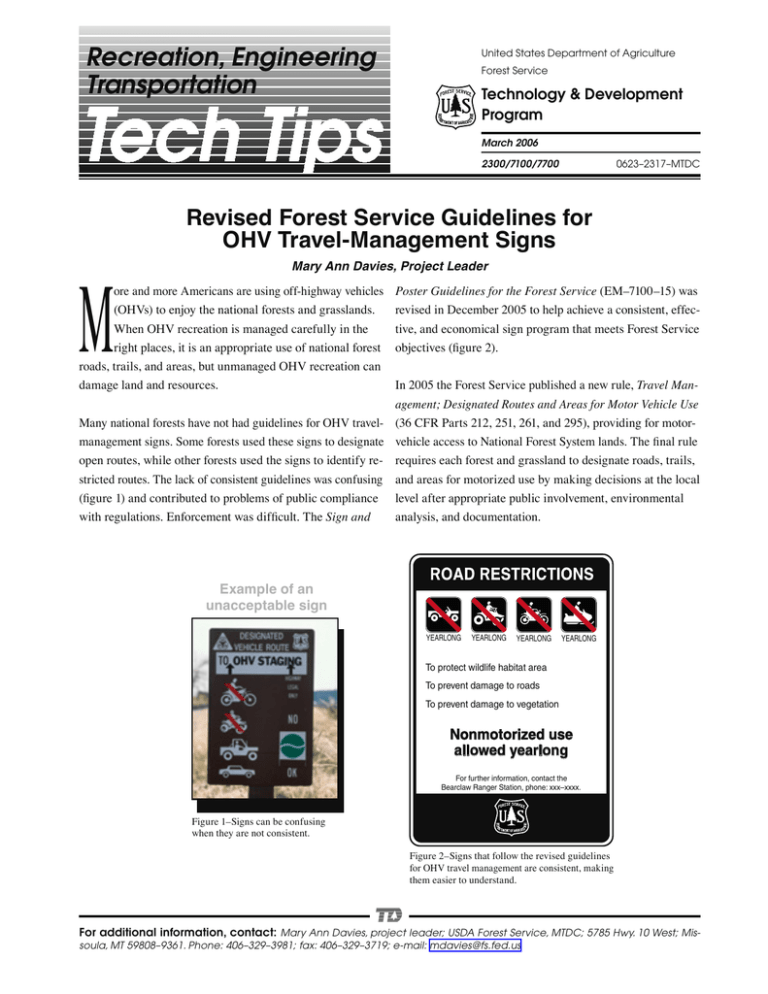
Recreation, Engineering
Transportation
United States Department of Agriculture
Forest Service
Technology & Development
Program
March 2006
2300/7100/7700
M
0623–2317–MTDC
Revised Forest Service Guidelines for
OHV Travel-Management Signs
Mary Ann Davies, Project Leader
ore and more Americans are using off-highway vehicles
(OHVs) to enjoy the national forests and grasslands.
When OHV recreation is managed carefully in the
right places, it is an appropriate use of national forest
roads, trails, and areas, but unmanaged OHV recreation can
damage land and resources.
Many national forests have not had guidelines for OHV travelmanagement signs. Some forests used these signs to designate
open routes, while other forests used the signs to identify restricted routes. The lack of consistent guidelines was confusing
(figure 1) and contributed to problems of public compliance
with regulations. Enforcement was difficult. The Sign and
Poster Guidelines for the Forest Service (EM–7100–15) was
revised in December 2005 to help achieve a consistent, effective, and economical sign program that meets Forest Service
objectives (figure 2).
In 2005 the Forest Service published a new rule, Travel Management; Designated Routes and Areas for Motor Vehicle Use
(36 CFR Parts 212, 251, 261, and 295), providing for motorvehicle access to National Forest System lands. The final rule
requires each forest and grassland to designate roads, trails,
and areas for motorized use by making decisions at the local
level after appropriate public involvement, environmental
analysis, and documentation.
Example of an
unacceptable sign
��������
��������
��������
��������
��������������������������������
��������������������������
�������������������������������
����������������
����������������
������������������������������������
�����������������������������������������
Figure 1–Signs can be confusing
when they are not consistent.
Figure 2–Signs that follow the revised guidelines
for OHV travel management are consistent, making
them easier to understand.
For additional information, contact: Mary Ann Davies, project leader; USDA Forest Service, MTDC; 5785 Hwy. 10 West; Missoula, MT 59808–9361. Phone: 406–329–3981; fax: 406–329–3719; e-mail: mdavies@fs.fed.us
1
Motor-vehicle-use maps will identify roads, trails, and areas
that are open to motorized use. Signs indicating motor-vehicle
closures or restrictions are not required for enforcement. As
a practical matter, signs may need to supplement the motorvehicle-use maps, drawing attention to some closures. Every
effort should be made to ensure that all designated routes
have route identification signs that correspond with the map.
Some major changes in the guidelines for OHV signs are:
• Travel-management signs will follow the standards and
guidance contained in the Manual on Uniform Traffic
Control Devices (MUTCD) and the Sign and Poster Guidelines for the Forest Service (EM 7100–15).
For example:
• Sign colors have changed from a brown legend on a white
background to a black legend on a white background.
• Signs on open roads maintained at levels 3, 4, or 5 need
letters that are at least 4 inches tall.
• Symbols for uses that are not allowed should be displayed.
These symbols have a red slash across them. Symbols for
allowed uses should not be displayed.
• Travel management symbols should be placed in the order
specified in the guidelines to ensure consistency.
Each region and forest is required to have an up-to-date sign
plan for roads and trails.
Forest Service employees can view and print a copy of the
Sign and Poster Guidelines for the Forest Service on the
Forest Service’s internal computer network at http://fsweb.wo.
fs.fed.us/eng/programs/signs.htm.
Anyone can view the Manual on Uniform Traffic Control
Devices (MUTCD), 2003 Edition, on the Internet at http://
mutcd.fhwa.dot.gov/.
Library Card
Davies, Mary Ann. 2006. Revised Forest Service guidelines
for consistent OHV travel-management signs. Tech Tip 0623–
2317–MTDC. Missoula, MT: U.S. Department of Agriculture
Forest Service, Missoula Technology and Development
Center. 2 p.
Describes the use of the Sign and Poster Guidelines for the
Forest Service (EM 7100–15) to establish consistent signs for
off-highway vehicles using the national forests and grasslands.
For further technical information, contact Mary Ann
Davies at MTDC.
Phone: 406–329–3981
Fax: 406–329–3719
E-mail: mdavies@fs.fed.us
Electronic copies of MTDC’s documents are available on
the Internet at http://www.fs.fed.us/t-d/ (Username: t-d,
Password: t-d).
The U.S. Department of Agriculture (USDA) prohibits discrimination in all its programs and
activities on the basis of race, color, national origin, age, disability, and where applicable,
sex, marital status, familial status, parental status, religion, sexual orientation, genetic
information, political beliefs, reprisal, or because all or part of an individual’s income
is derived from any public assistance program. (Not all prohibited bases apply to all
programs.) Persons with disabilities who require alternative means for communication of
program information (Braille, large print, audiotape, etc.) should contact USDA’s TARGET
Center at (202) 720-2600 (voice and TDD). To file a complaint of discrimination, write to
USDA, Director, Office of Civil Rights, 1400 Independence Avenue, S.W., Washington,
D.C. 20250-9410, or call (800) 795-3272 (voice) or (202) 720-6382 (TDD). USDA is an
equal opportunity provider and employer.
2
Keywords: closures, motor vehicle use maps, off-highway
vehicles, travel plans
Forest Service and Bureau of Land Management employees
can search a more complete collection of MTDC’s documents, videos, and CDs on their internal computer
network at http://fsweb.mtdc.wo.fs.fed.us/search/.

